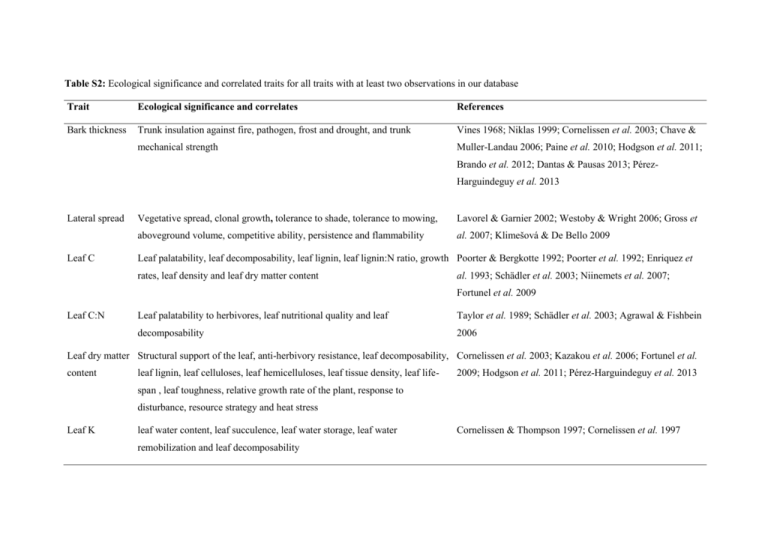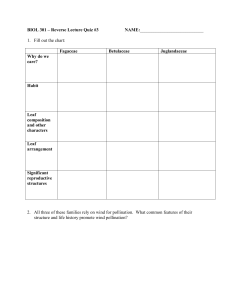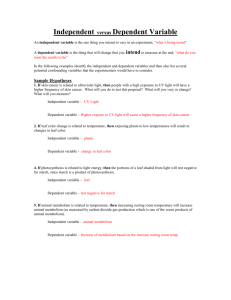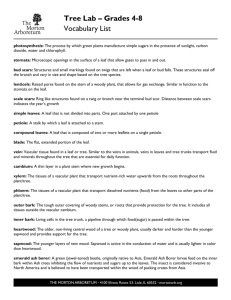ele12508-sup-0002-TableS2
advertisement

Table S2: Ecological significance and correlated traits for all traits with at least two observations in our database Trait Ecological significance and correlates References Bark thickness Trunk insulation against fire, pathogen, frost and drought, and trunk Vines 1968; Niklas 1999; Cornelissen et al. 2003; Chave & mechanical strength Muller-Landau 2006; Paine et al. 2010; Hodgson et al. 2011; Brando et al. 2012; Dantas & Pausas 2013; PérezHarguindeguy et al. 2013 Lateral spread Leaf C Vegetative spread, clonal growth, tolerance to shade, tolerance to mowing, Lavorel & Garnier 2002; Westoby & Wright 2006; Gross et aboveground volume, competitive ability, persistence and flammability al. 2007; Klimešová & De Bello 2009 Leaf palatability, leaf decomposability, leaf lignin, leaf lignin:N ratio, growth Poorter & Bergkotte 1992; Poorter et al. 1992; Enriquez et rates, leaf density and leaf dry matter content al. 1993; Schädler et al. 2003; Niinemets et al. 2007; Fortunel et al. 2009 Leaf C:N Leaf palatability to herbivores, leaf nutritional quality and leaf Taylor et al. 1989; Schädler et al. 2003; Agrawal & Fishbein decomposability 2006 Leaf dry matter Structural support of the leaf, anti-herbivory resistance, leaf decomposability, Cornelissen et al. 2003; Kazakou et al. 2006; Fortunel et al. content leaf lignin, leaf celluloses, leaf hemicelluloses, leaf tissue density, leaf life- 2009; Hodgson et al. 2011; Pérez-Harguindeguy et al. 2013 span , leaf toughness, relative growth rate of the plant, response to disturbance, resource strategy and heat stress Leaf K leaf water content, leaf succulence, leaf water storage, leaf water remobilization and leaf decomposability Cornelissen & Thompson 1997; Cornelissen et al. 1997 Trait Ecological significance and correlates References Leaf N Leaf decomposability, leaf palatability, net photosynthetic capacity, Taylor et al. 1989; Reich et al. 1992, 1997, 1999; Enriquez maximum respiration rate, , mass-based maximum photosynthetic rate, leaf et al. 1993; Cornelissen et al. 1997, 2003; Schädler et al. diffusive conductance, leaf lignin:N ratio, leaf density, leaf dry matter 2003; Niinemets et al. 2007; Fortunel et al. 2009 content, leaf lifespan, relative growth rate and N availability in the soil, Leaf N:P ratio Leaf P Limitation by soil N in relation to P, relative growth rate and biomass Koerselman & Meuleman 1996; Güsewell 2004; Reich & production Oleksyn 2004 Leaf decomposability, nutritional quality to herbivores, relative growth rate Enriquez et al. 1993; Cornelissen et al. 2003; Kazakou et al. and P availability in the soil 2006 Leaf tissue Photosynthetic potential per unit dry mass, concentrations of assimilative leaf Niinemets 2001; Westoby et al. 2002; Niinemets et al. 2007 density compounds, intercellular transfer conductance to CO2, leaf elasticity, leaf life-span, leaf N content, precipitation and solar irradiance. Leaf δ13C Water use efficiency, the ratio of internal to atmospheric CO2 concentration, Damesin et al. 1998; Van de Water et al. 2002; Pérez- pre-down water potential, leaf thickness, leaf N, stomatal conductance, Harguindeguy et al. 2013 stomatal density, soil moisture, air temperature, atmospheric pCO2 and atmospheric pO2 Plant height Competitive vigor, whole plant fecundity, growth time between disturbances, Gaudet & Keddy 1988; Thomas & Bazzaz 1999; Cornelissen photosynthetic behavior and probability of fire escape et al. 2003; Wakeling et al. 2011; Higgins et al. 2012 Trait Ecological significance and correlates References Specific leaf Mechanical strength, leaf N, lignin content, leaf digestibility, leaf life-span, Reich et al. 1997, 1999, 1992; Niinemets & Kull 1994; area leaf palatability, leaf decomposability, nutrient strategy, shade-tolerance, Cornelissen et al. 1996, 2003, 2004; Poorter & De Jong relative growth rate, maximum photosynthetic rate, maximum respiration 1999; Niinemets 2001; Westoby et al. 2002; Schädler et al. rate, net photosynthetic capacity, leaf diffusive conductance, leaf thickness, 2003; Kazakou et al. 2006; Poorter et al. 2009; Hodgson et leaf toughness, leaf tissue density, leaf habit, leaf succulence, submergence, al. 2011 light availability, temperature, water stress and CO2 atmospheric concentration Wood density Growth-survival tradeoff, vegetative recovery ratio, mechanical resistance (Enquist et al. 1999; Santiago et al. 2004; Chave et al. 2006; against physical damage, resistance against pathogen, water storage in the Van Gelder et al. 2006; Curran et al. 2008; Poorter et al. trunk, soil fertility, protection against mechanical damage, net CO2 2008; Pérez-Harguindeguy et al. 2013) assimilation per unit leaf area, net CO2 assimilation per unit leaf mass, hydraulic safety, precipitation and altitude References 1. Agrawal, A.A. & Fishbein, M. (2006). Plant defense syndromes. Ecology, 87, S132–149. 2. Blonder, B., Buzzard, V. & Simova, I. (2012). The leaf-area shrinkage effect can bias paleoclimate and ecology research. Am. J. Bot., 99, 1756–63. 3. Bragg, J. & Westoby, M. (2002). Leaf size and foraging for light in a sclerophyll woodland. Funct. Ecol., 16, 633–639. 4. Brando, P., Nepstad, D., Balch, J., Bolker, B., Christman, M., Coe, M., et al. (2012). Fire‐induced tree mortality in a neotropical forest: the roles of bark traits, tree size, wood density and fire behavior. Glob. Chang. Biol., 18, 630–641. 5. Chave, J. & Muller-Landau, H. (2006). Regional and phylogenetic variation of wood density across 2456 neotropical tree species. Ecol. Appl., 16, 2356– 2367. 6. Chave, J., Muller-Landau, H.C., Baker, T.R., Easdale, T. a, ter Steege, H. & Webb, C.O. (2006). Regional and phylogenetic variation of wood density across 2456 Neotropical tree species. Ecol. Appl., 16, 2356–67. 7. Cornelissen, J. (1999). Leaf structure and defence control litter decomposition rate across species and life forms in regional floras on two continents. New Phytol., 143, 191–200. 8. Cornelissen, J., Diez, P. & Hunt, R. (1996). Seedling growth, allocation and leaf attributes in a wide range of woody plant species and types. J. Ecol., 84, 755–765. 9. Cornelissen, J. & Thompson, K. (1997). Functional leaf attributes predict litter decomposition rate in herbaceous plants. New Phytol., 135, 109–114. 10. Cornelissen, J., Werger, M., Castro-Diéz, P., van Rheenen, J. & Rowland, A. (1997). Foliar nutrients in relation to growth, allocation and leaf traits in seedlings of a wide range of woody plant species and types. Oecologia, 111, 460–469. 11. Cornelissen, J.H.C., Lavorel, S., Garnier, E., Díaz, S., Buchmann, N., Gurvich, D.E., et al. (2003). A handbook of protocols for standardised and easy measurement of plant functional traits worldwide. Aust. J. Bot., 51, 335. 12. Cornelissen, J.H.C., Quested, H.M., Gwynn-Jones, D., Van Logtestijn, R.S.P., De Beus, M.A. H., Kondratchuk, A., et al. (2004). Leaf digestibility and litter decomposability are related in a wide range of subarctic plant species and types. Funct. Ecol., 18, 779–786. 13. Curran, T.J., Gersbach, L.N., Edwards, W. & Krockenberger, A.K. (2008). Wood density predicts plant damage and vegetative recovery rates caused by cyclone disturbance in tropical rainforest tree species of North Queensland, Australia. Austral Ecol., 33, 442–450. 14. Damesin, C., Rambal, S. & Joffre, R. (1998). Seasonal and annual changes in leaf δ13C in two co‐occurring Mediterranean oaks: relations to leaf growth and drought progression. Funct. Ecol., 12, 778–785. 15. Dantas, V.D.L. & Pausas, J.G. (2013). The lanky and the corky: fire-escape strategies in savanna woody species. J. Ecol., 101, 1265–1272. 16. Enquist, B., West, G., Charnov, E. & Brown, J. (1999). Allometric scaling of production and life-history variation in vascular plants. Nature, 88, 907–912. 17. Enriquez, S., Duarte, C. & Sand-Jensen, K. (1993). Patterns in decomposition rates among photosynthetic organisms: the importance of detritus C: N: P content. Oecologia, 94, 457–471. 18. Fortunel, C., Garnier, E., Joffre, R., Kazakou, E., Quested, H., Grigulis, K., et al. (2009). Leaf traits capture the effects of land use changes and climate on litter decomposability of grasslands across Europe. Ecology, 90, 598–611. 19. Gaudet, C. & Keddy, P. (1988). A comparative approach to predicting competitive ability from plant traits. Nature 334, 242–243. 20. Van Gelder, H., Poorter, L. & Sterck, F. (2006). Wood mechanics, allometry, and life-history variation in a tropical rain forest tree community. New Phytol., 171, 367–378. 21. Gross, N., Suding, K. & Lavorel, S. (2007). Leaf dry matter content and lateral spread predict response to land use change for six subalpine grassland species. J. Veg. Sci., 18, 289–300. 22. Güsewell, S. (2004). N: P ratios in terrestrial plants: variation and functional significance. New Phytol., 164, 243–266. 23. Higgins, S.I., Bond, W.J., Combrink, H., Craine, J.M., February, E.C., Govender, N., et al. (2012). Which traits determine shifts in the abundance of tree species in a fire-prone savanna? J. Ecol., 100, 1400–1410. 24. Hodgson, J., Montserrat-Martí, G., Charles, M., Jones, G., Wilson, P., Shipley, B., et al. (2011). Is leaf dry matter content a better predictor of soil fertility than specific leaf area? Ann. Bot., 108, 1337–1345. 25. Kazakou, E., Vile, D., Shipley, B., Gallet, C. & Garnier, E. (2006). Co-variations in litter decomposition, leaf traits and plant growth in species from a Mediterranean old-field succession. Funct. Ecol., 20, 21–30. 26. Klimešová, J. & De Bello, F. (2009). CLO-PLA: the database of clonal and bud bank traits of Central European flora. J. Veg. Sci., 20, 511–516. 27. Koerselman, W. & Meuleman, A. (1996). The vegetation N: P ratio: a new tool to detect the nature of nutrient limitation. J. Appl. Ecol., 33, 1441–1450. 28. Lavorel, S. & Garnier, E. (2002). Predicting changes in community composition and ecosystem functioning from plant traits: revisiting the Holy Grail. Funct. Ecol., 545–556. 29. Niinemets, Ü. (2001). Global-scale climatic controls of leaf dry mass per area, density, and thickness in trees and shrubs. Ecology, 82, 453–469. 30. Niinemets, Ü. & Kull, K. (1994). Leaf weight per area and leaf size of 85 Estonian woody species in relation to shade tolerance and light availability. For. Ecol. Manage., 70, 1–10. 31. Niinemets, U., Portsmuth, A., Tena, D., Tobias, M., Matesanz, S. & Valladares, F. (2007). Do we underestimate the importance of leaf size in plant economics? Disproportional scaling of support costs within the spectrum of leaf physiognomy. Ann. Bot., 100, 283–303. 32. Niklas, K.J. (1999). The mechanical role of bark. Am. J. Bot., 86, 465–469. 33. Paine, C., Stahl, C., Courtois, E., Patiño, S., Sarmiento, C. & Baraloto, C. (2010). Functional explanations for variation in bark thickness in tropical rain forest trees. Funct. Ecol., 24, 1202–1210. 34. Pérez-Harguindeguy, N., Díaz, S., Garnier, E., Lavorel, S., Poorter, H., Jaureguiberry, P., et al. (2013). New handbook for standardised measurement of plant functional traits worldwide. Aust. J. Bot., 61, 167–234. 35. Poorter, H. & Bergkotte, M. (1992). Chemical composition of 24 wild species differing in relative growth rate. Plant. Cell Environ., 15, 221–229. 36. Poorter, H., Gifford, R., Kriedemann, P. & Wong, S. (1992). A quantitative-analysis of dark respiration and carbon content as factors in the growthresponse of plants to elevated CO2. Aust. J. Bot., 40, 501–513. 37. Poorter, H. & De Jong, R. (1999). A comparison of specific leaf area, chemical composition and leaf construction costs of field plants from 15 habitats differing in productivity. New Phytol., 143, 163–176. 38. Poorter, H., Niinemets, Ü., Poorter, L., Wright, I.J. & Villar, R. (2009). Causes and consequences of variation in leaf mass per area (LMA): a meta‐analysis. New Phytol., 182, 565–588. 39. Poorter, L. & Rozendaal, D. (2008). Leaf size and leaf display of thirty-eight tropical tree species. Oecologia, 158, 35–46. 40. Poorter, L., Wright, S., Paz, H., Ackerly, D., Condit, R., Ibarra-Manríquez, G., et al. (2008). Are functional traits good predictors of demographic rates? Evidence from five Neotropical forests. Ecology, 89, 1908–1920. 41. Reich, P. & Oleksyn, J. (2004). Global patterns of plant leaf N and P in relation to temperature and latitude. Proc. Natl. Acad. Sci. USA, 101, 11001– 11006. 42. Reich, P., Walters, M. & Ellsworth, D. (1992). Leaf life-span in relation to leaf, plant, and stand characteristics among diverse ecosystems. Ecol. Monogr., 62, 365–392. 43. Reich, P.B., Ellsworth, D.S., Walters, M.B., Vose, J.M., Gresham, C., Volin, J.C., et al. (1999). Generality of leaf trait relationships: a test across six biomes. Ecology, 80, 1955–1969. 44. Reich, P.B., Walters, M.B. & Ellsworth, D.S. (1997). From tropics to tundra: global convergence in plant functioning. Proc. Natl. Acad. Sci. USA, 94, 13730–13734. 45. Santiago, L.S., Goldstein, G., Meinzer, F.C., Fisher, J.B., Machado, K., Woodruff, D., et al. (2004). Leaf photosynthetic traits scale with hydraulic conductivity and wood density in Panamanian forest canopy trees. Oecologia, 140, 543–450. 46. Schädler, M., Jung, G., Auge, H. & Brandl, R. (2003). Palatability, decomposition and insect herbivory: patterns in a successional old‐field plant community. Oikos, 103, 121–132. 47. Taylor, B., Parkinson, D. & Parsons, W. (1989). Nitrogen and lignin content as predictors of litter decay rates: a microcosm test. Ecology, 70, 97–104. 48. Thomas, S. & Bazzaz, F. (1999). Asymptotic height as a predictor of photosynthetic characteristics in Malaysian rain forest trees. Ecology, 80, 1607–1622. 49. Vile, D., Garnier, E., Shipley, B., Laurent, G., Navas, M., Roumet, C., et al. (2005). Specific leaf area and dry matter content estimate thickness in laminar leaves. Ann. Bot., 96, 1129–36. 50. Vines, R. (1968). Heat transfer through bark, and the resistance of trees to fire. Aust. J. Bot., 16, 499–514. 51. Wakeling, J.L., Staver, A. C. & Bond, W.J. (2011). Simply the best: the transition of savanna saplings to trees. Oikos, 120, 1448–1451. 52. Van de Water, P., Leavitt, S. & Betancourt, J. (2002). Leaf δ13C variability with elevation, slope aspect, and precipitation in the southwest United States. Oecologia, 132, 332–343. 53. Westoby, M., Falster, D.S., Moles, A.T., Vesk, P.A. & Wright, I.J. (2002). Plant ecological strategies: some leading dimensions of variation between species. Annu. Rev. Ecol. Syst., 33, 125–159. 54. Westoby, M. & Wright, I. (2006). Land-plant ecology on the basis of functional traits. Trends Ecol. Evol., 21, 261–268.









